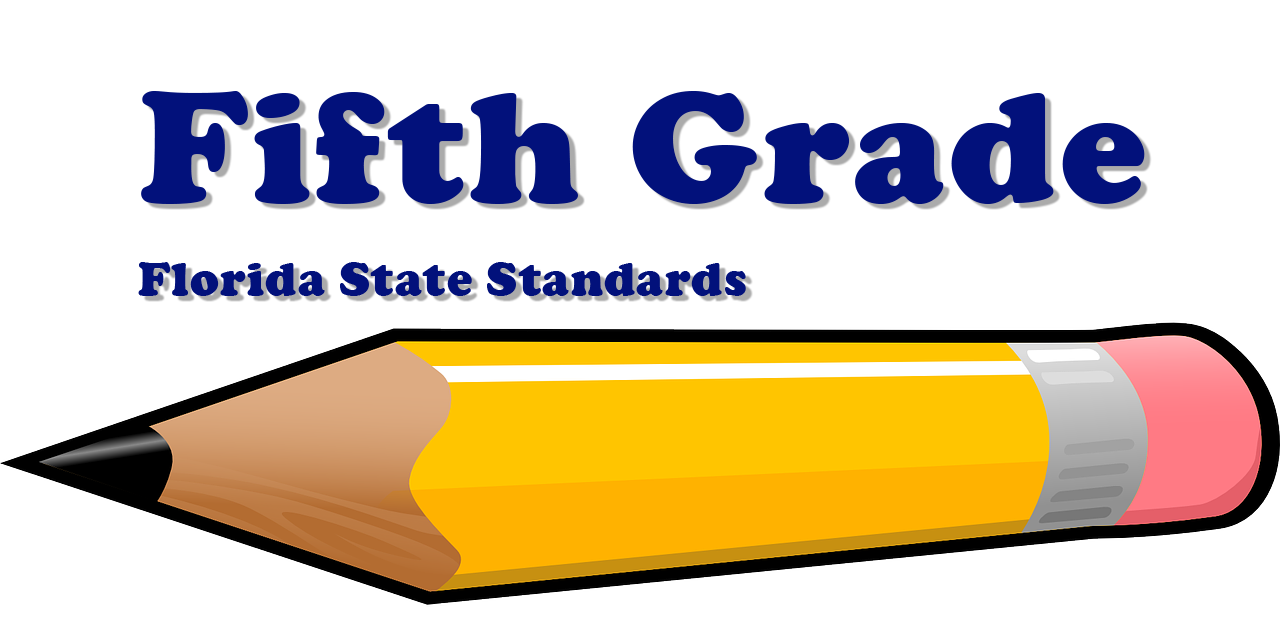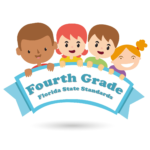We know that for many people, one of the first concerns they have with homeschooling is “falling behind.” While seasoned homeschoolers will tell you, there’s no such thing (all kids learn at their own pace, whether at home or school, and homeschooling gives you the freedom to move at that pace); sometimes it’s comforting to check-in with what’s required in the public schools. Reading through the state standards can be overwhelming if you aren’t a teacher, so we’ve condensed them into easy to read and understand plain language. You can access the original state standards on CPALMS.org
Use can use these standards to help you decide what level of curriculum to use, to keep track of gained skills during the year, or to assess progress throughout the year.
Download the Checklist for Fifth Grade Florida State Standards.
ENGLISH LANGUAGE ARTS (ELA), FIFTH GRADE
WRITING
- Demonstrate fluent and legible cursive skills
SPELLING
- Spell grade-appropriate words, including use of reference materials for corrections
GRAMMAR WHEN WRITING OR SPEAKING
- Explain the function of conjunctions, prepositions, and interjections
- Form and use the perfect verb tenses; recognize inappropriate shifts in verb tense
- Use of correlative conjunctions (either/or, neither/nor)
SENTENCE STRUCTURE
- Appropriate use of commas for a range of purposes within a sentence
- Appropriately underlining or use of quotation marks and italics to indicate titles
VOCABULARY
- Use multiple strategies to decode and clarify the meaning of unknown and multiple-meaning words in grade-level texts
- Interpret figurative language, including similes and metaphors, common idioms, adages, and proverbs, as well as the relationship between words such as synonyms, antonyms, and homographs
READING
- Read on-level text with purpose and understanding, orally and silently, with appropriate accuracy, rate, and expression, self-correcting words as needed
- Read on-level text with appropriate comprehension, rate, and expression
- Decode multisyllable words in and out of context at grade level
READING COMPREHENSION
- Compare/contrast varieties of English (dialects, etc) used in various texts
- Quote accurately from a text in discussions
- Identify two or more main ideas of a text and provide support
- Explain the relationships between two or more individuals, ideas, etc. in a text
- Compare/contrast the overall structure (chronology, cause/effect, problem/solution) of events, ideas, information, etc. in two or more texts, including analysis of multiple accounts of the same event or topic, noting important similarities and differences, as well as point of view
- Articulate how an author supported particular points they made in a text
- Read and comprehend grade-level texts, including history/social studies, science, and technical texts, as well as stories, drama, and poetry, with appropriate grade-level comprehension
- Determine a theme and summarize a story, drama, or poem from details, including how characters respond and reflections of the narrator
- Recognize how the narrator’s point of view influences how events are described
- Analyze how visual elements contribute to the meaning/tone/beauty of a text (graphic novels, poetry, multimedia presentations)
- Compare/contrast stories in the same genre on their approaches to similar topics
- Ability to have grade-appropriate discussions about texts, including preparation, drawing conclusions, asking questions and follow ups, and expressing understanding
- Summarize text read, heard, or presented in diverse formats
WRITING/COMPOSITION
- Expand, combine, reduce sentences for meaning, reader/listener interest, and style
- Report on a topic or present an opinion logically, with appropriate and relevant facts and details, speaking at an understandable pace
- Include multimedia components in presentations when appropriate
- Write opinion pieces and informative texts on topics or texts with a clear introduction, organizational structure, supportive facts, details, and evidence, domain-specific vocabulary, and a relevant conclusion
- Write narratives with appropriate introductions and organize events to unfold naturally, including use of dialogue, descriptions, and pacing to show characters’ responses, transitional words to manage sequence of events, concrete words and sensory details to convey precise events, and appropriate conclusion.
- Produce grade-level appropriate clear and coherent writing, in which the development and organization are appropriate to task, purpose, and audience
- Continue growth on editing, accepting feedback from adults and peers
- Ability to pull from various research sources and organize information, including providing a list of sources
- Write routinely over extended time frames (research, reflection, revision) or shorter time frames (single sitting)
PROBLEM SOLVING
- Draw on information from multiple sources to solve problems or answer questions
Download the Checklist for Fifth Grade Florida State Standards.
MATH, FIFTH GRADE
GEOMETRY
- Classify and organize two-dimensional figures into Venn diagrams based on attributes
FRACTIONS AND DECIMALS
- Add, subtract, multiply, and divide decimals to the hundredths
- Add and subtract fractions with unlike denominators by replacing with common denominators
- Solve word problems with addition and subtraction of fractions referring to the same whole, including unlike denominators
- Interpret a fraction as a division of the numerator by the denominator. Solve word problems involving division of whole numbers leading to answers in the form of fractions or mixed numbers
- Multiply and divide fractions and whole numbers with fractions
- Recognize the scaling of multiplication as it relates to fractions; when multiplying a given number by a fraction larger than one, the product will be greater than the given number and when multiplying by a fraction smaller than one, the product will be smaller
- Solve real-world and word problems involving multiplication of fractions and mixed numbers
MEASUREMENT
- Convert measurement units within a given measurement system and use these conversations in multi-step problems
- Make a line plot displaying a data set of measurements in fractions of a unit (1/2, 1/4, 1/8). Use operations on fractions for this grade to solve problems using this information.
- Understand volume as an attribute of solid figures and understand concepts of volume measurement in standard and non-standard units
- Relate volume to the operations of multiplication and addition to solve real-world mathematical problems involving volume. Use the formulas V = L x W x H and V = B x H for rectangular prisms. Recognize volume as additive with solid, non-overlapping figures
PLACE VALUE/NUMBER FLUENCY
- Recognize in a multi-digit number, a digit in the one place represents 10 times as much as in the place to its right and 1/10 of the place to its left
- Use whole number exponents to denote powers of 10. Explain patterns in the number of zeros of the product when multiplying a number by powers of 10 and patterns in the placement of the decimal point when a decimal is multiplied or divided by a power of 10.
- Read, write, and compare decimals to thousandths, including the use of symbols <, >, =
- Use place value to round decimals to any place
- Generate two numerical patterns using two given rules. Identify apparent relationships between corresponding terms. Form ordered pairs consisting of corresponding terms from the two patterns, and graph the ordered pairs on a coordinate plane. For example, given the rule “Add 3” and the starting number 0, and given the rule “Add 6” and the starting number 0, generate terms in the resulting sequences, and observe that the terms in one sequence are twice the corresponding terms in the other sequence. Explain informally why this is so.
EQUATIONS
- Fluently multiply multi-digit whole numbers
- Find whole number quotients of whole numbers of up to four-digit dividends and two-digit divisors
- Use parentheses, brackets, or braces in numerical expressions
GRAPHING
- Understand how to identify and place coordinates on an X/Y grid
Download the Checklist for Fifth Grade Florida State Standards.



